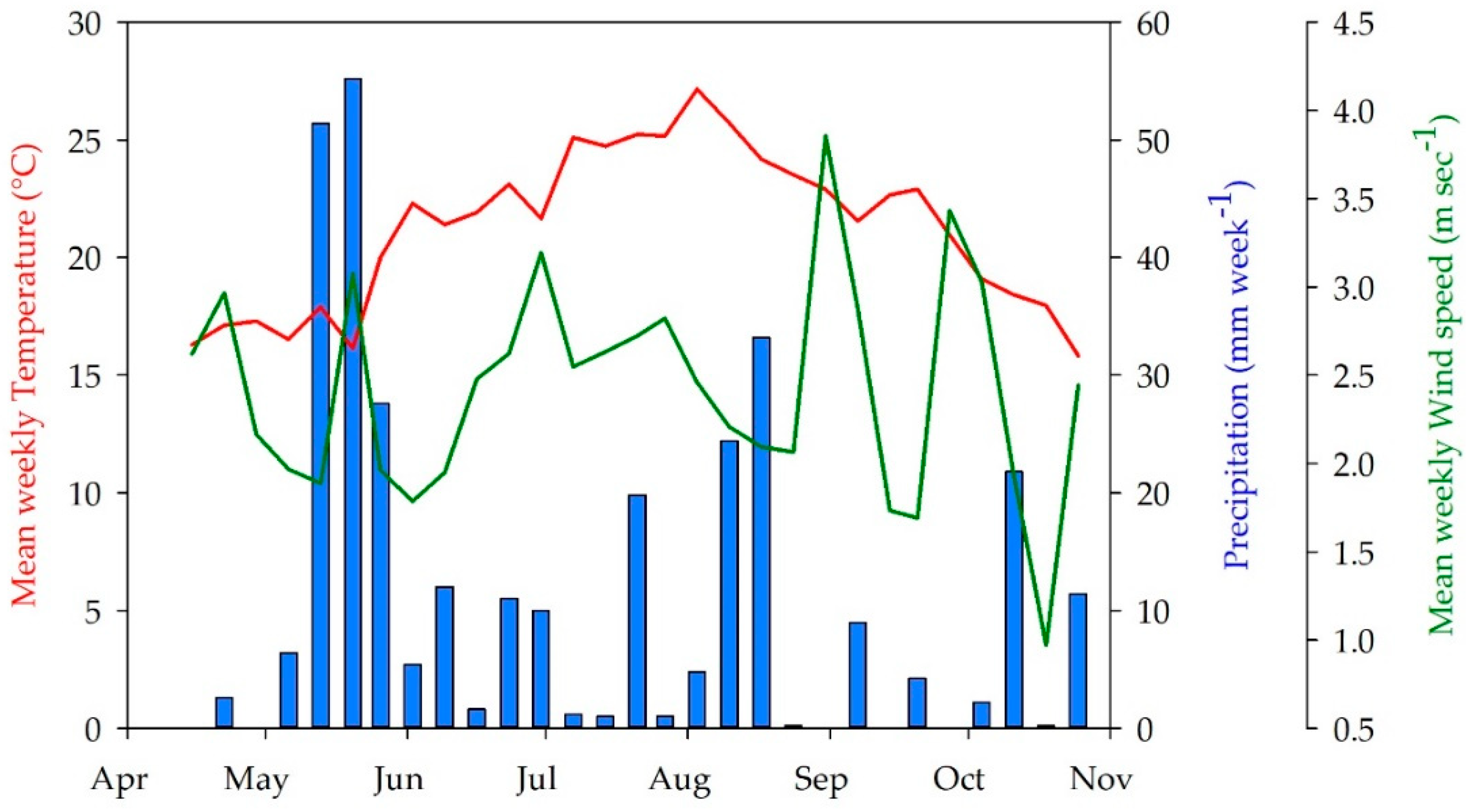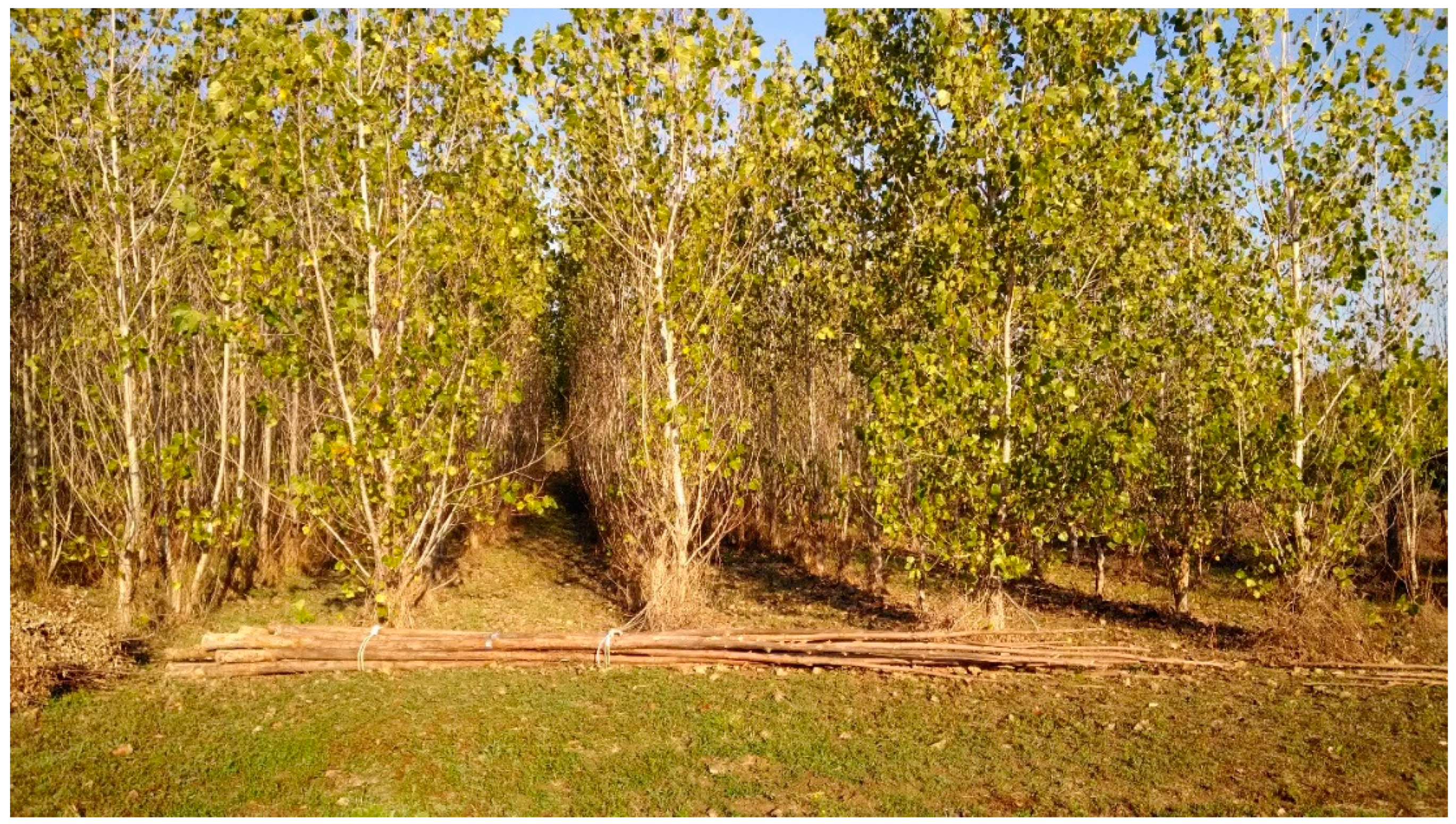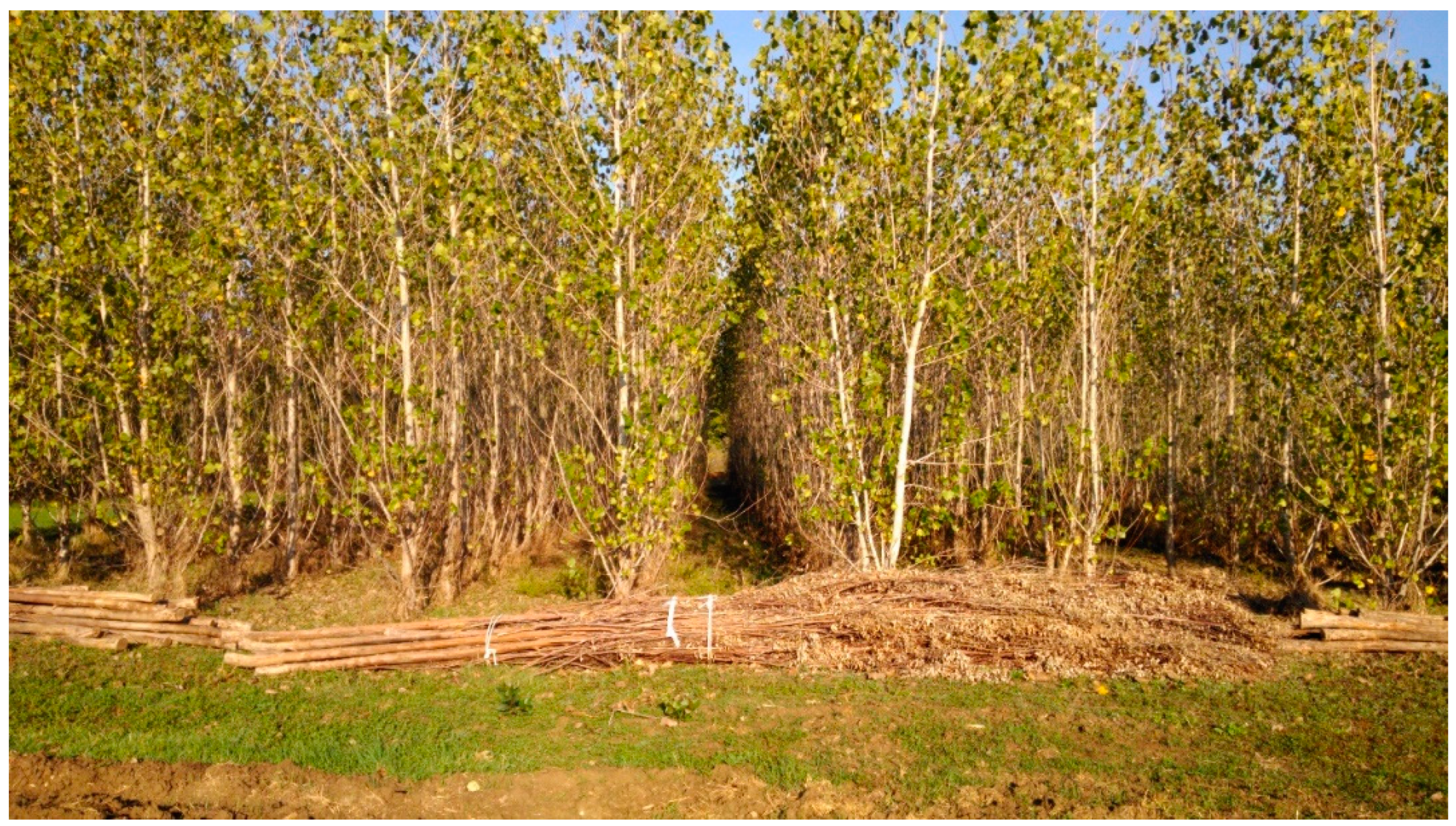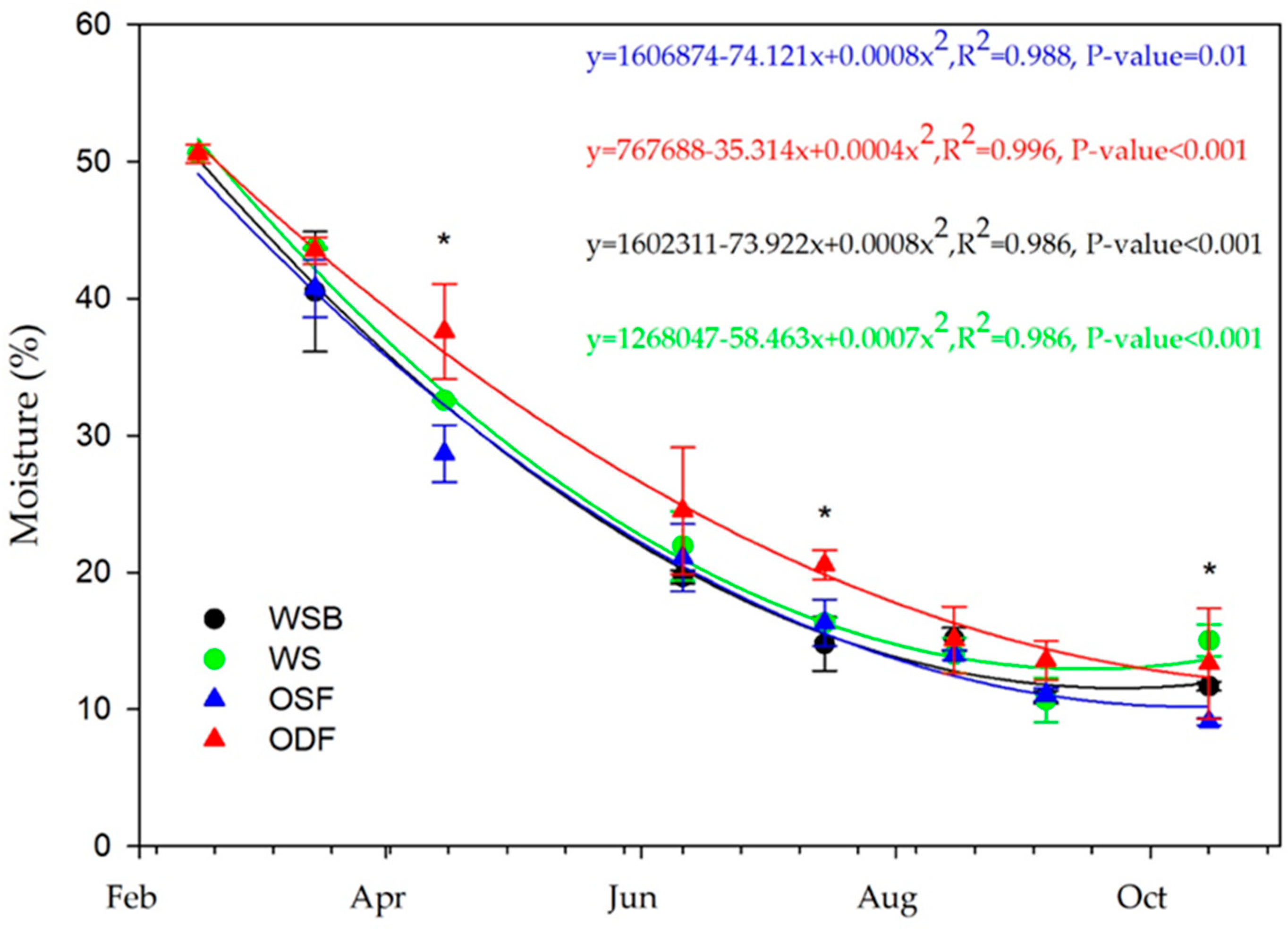Medium Rotation Eucalyptus Plant: A Comparison of Storage Systems
Abstract
1. Introduction
2. Materials and Methods
2.1. Studying Site
2.2. Storage Systems
- -
- Outdoor storage of whole stems without branches (WS).
- -
- Outdoor storage of whole stems with Branches (WSB).
- -
- Open shed storage of firewood logs in mesh bags (OSF).
- -
- Outdoor firewood logs in mesh bags (ODF).
2.2.1. Outdoor Storage of Eucalyptus Whole Stems with (WSB) and without (WS) Branches
2.2.2. Firewood Logs in Meshed Bags: Outdoor (ODF) and Open Shed (OSF) Storages
2.3. Climatic Data
2.4. Statistical Analysis
3. Results
3.1. Climatic Data
3.2. Harvested Plants Characteristic
3.3. Moisture Dynamic and Dry Matter Loss
4. Discussion
5. Conclusions
Author Contributions
Funding
Conflicts of Interest
References
- Dhillon, R.S.; von Wuehlisch, G. Mitigation of global warming through renewable biomass. Biomass Bioenergy 2013, 48, 75–89. [Google Scholar] [CrossRef]
- Pari, L.; Scarfone, A.; Santangelo, E.; Figorilli, S.; Crognale, S.; Petruccioli, M.; Suardi, A.; Gallucci, F.; Barontini, M. Alternative storage systems of Arundo donax L. and characterization of the stored biomass. Ind. Crops Prod. 2015, 75, 59–65. [Google Scholar] [CrossRef]
- Pecenka, R.; Lenz, H.; Jekayinfa, S.O.; Ho, T. Influence of Tree Species, Harvesting Method and Storage on Energy Demand and Wood Chip Quality When Chipping Poplar, Willow and Black Locust. Agriculture 2020, 10, 116. [Google Scholar] [CrossRef]
- Alig, R.J.; Adams, D.M.; Mccarl, B.A.; Ince, P.J. Economic potential of short-rotation woody crops on agricultural land for pulp fiber production in the United States. For. Prod. J. 2000, 50, 67–74. [Google Scholar]
- Civitarese, V.; Spinelli, R.; Barontini, M.; Gallucci, F.; Santangelo, E.; Acampora, A.; Scarfone, A.; del Giudice, A.; Pari, L. Open-Air Drying of Cut and Windrowed Short-Rotation Poplar Stems. Bioenergy Res. 2015, 8, 1614–1620. [Google Scholar] [CrossRef]
- Santangelo, E.; Scarfone, A.; Del Giudice, A.; Acampora, A.; Alfano, V.; Suardi, A.; Pari, L. Harvesting systems for poplar short rotation coppice. Ind. Crops Prod. 2015, 75, 85–92. [Google Scholar] [CrossRef]
- Spinelli, R.; Magagnotti, N.; Picchi, G.; Lombardini, C.; Nati, C. Upsized Harvesting Technology for Coping with the New Trends in Short-Rotation Coppice; American Society of Agricultural and Biological Engineers: St. Joseph, MI, USA, 2011. [Google Scholar]
- Spinelli, R.; Schweier, J.; De Francesco, F. Harvesting techniques for non-industrial biomass plantations. Biosyst. Eng. 2012, 113, 319–324. [Google Scholar] [CrossRef]
- Fernández, M.; Alaejos, J.; Andivia, E.; Vázquez-Piqué, J.; Ruiz, F.; López, F.; Tapias, R. Eucalyptus x urograndis biomass production for energy purposes exposed to a Mediterranean climate under different irrigation and fertilisation regimes. Biomass Bioenergy 2018, 111, 22–30. [Google Scholar] [CrossRef]
- Bouvet, A.; Nguyen-The, N.; Melun, F. Nutrient concentration and allometric models for hybrid eucalyptus planted in France. Ann. For. Sci. 2013, 70, 251–260. [Google Scholar] [CrossRef]
- Mughini, G. Suggestions for sustainable Eucalyptus clonal cultivation in Mediterranean climate areas of central and southern Italy. Forest@ 2016, 13, 47–58. [Google Scholar] [CrossRef]
- Gasparin, P.; Tabacchi, G. (Eds.) L’Inventario Nazionale delle Foreste e dei Serbatoi Forestali di Carbonio INFC2005. Secondo Inventario Forestale Nazionale Italiano. Metodi e Risultati; Ministero; Edagricole: Milano, Italy, 2011. [Google Scholar]
- Pignatti, G.; Verani, S.; Sperandio, G. Produzione di legna da ardere da cedui di eucalipto a turno breve: Produttività di lavoro e costi. L’Italia For. Mont. 2019, 74, 217–226. [Google Scholar] [CrossRef]
- Günther, B.; Gebauer, K.; Barkowski, R.; Rosenthal, M.; Bues, C.T. Calorific value of selected wood species and wood products. Eur. J. Wood Wood Prod. 2012, 70, 755–757. [Google Scholar] [CrossRef]
- Marková, I.; Ladomerský, J.; Hroncová, E.; Mračková, E. Thermal parameters of beech wood dust. BioResources 2018, 13, 3098–3109. [Google Scholar] [CrossRef]
- Miranda, M.T.; Arranz, J.I.; Rojas, S.; Montero, I. Energetic characterization of densified residues from Pyrenean oak forest. Fuel 2009, 88, 2106–2112. [Google Scholar] [CrossRef]
- Francescato, E.; Antonini, V.; Zuccoli Bergomi, L. Wood Fuels HandbooK; AIEL—Italian Agriforestry Energy Association: Legnaro, Italy, 2008; ISBN 9788578110796. [Google Scholar]
- Pari, L.; Bergonzoli, S.; Cetera, P.; Mattei, P.; Alfano, V.; Rezaei, N.; Suardi, A.; Toscano, G.; Scarfone, A. Storage of Fine Woodchips from a Medium Rotation Coppice Eucalyptus Plantation in Central Italy. Energies 2020, 13, 2355. [Google Scholar] [CrossRef]
- Yuntenwi, E.A.T.; MacCarty, N.; Still, D.; Ertel, J. Laboratory study of the effects of moisture content on heat transfer and combustion efficiency of three biomass cook stoves. Energy Sustain. Dev. 2008, 12, 66–77. [Google Scholar] [CrossRef]
- Obernberger, I. Decentralized biomass combustion: State of the art and future development. Biomass Bioenergy 1998, 14, 33–56. [Google Scholar] [CrossRef]
- Nurmi, J. Measurement and evaluation of wood fuel. Biomass Bioenergy 1992, 2, 157–171. [Google Scholar] [CrossRef]
- Jirjis, R. Storage and drying of wood fuel. Biomass Bioenergy 1995, 9, 181–190. [Google Scholar] [CrossRef]
- Ławniczek-Walczyk, A.; Golofit-Szymczak, M.; Cyprowski, M.; Górny, R.L. Exposure to harmful microbiological agents during the handling of biomass for power production purposes. Med. Pr. 2012, 63, 395–407. [Google Scholar]
- Krigstin, S.; Wetzel, S. A review of mechanisms responsible for changes to stored woody biomass fuels. Fuel 2016, 175, 75–86. [Google Scholar] [CrossRef]
- Palmieri, N.; Suardi, A.; Pari, L. Italian Consumers’ Willingness to Pay for Eucalyptus Firewood. Sustainabilty 2020, 12, 2629. [Google Scholar] [CrossRef]
- Colorio, G.; Beni, C.; Facciotto, G.; Allegro, G.; Frison, G. Influenza del tipo di lavorazione reimpianto su accrescimento e stato fitosanitario del pioppo. L’Informatore Agrario 1996, 52, 51–60. [Google Scholar]
- Laurila, J.; Lauhanen, R. Moisture content of norway spruce stump wood at clear cutting areas and roadside storage sites. Silva Fenn. 2010, 44, 427–434. [Google Scholar] [CrossRef]
- ISO. ISO 18134-1:2015 Solid Biofuels—Determination of Moisture Content—Oven Dry Method—Part 1: Total Moisture—Reference Method. 2015. Available online: http://store.uni.com/catalogo/uni-en-iso-18134-1-2015?___store=en&___from_store=it (accessed on 10 January 2020).
- Hammer, Ø.; Harper, D.A.T.; Ryan, P.D. Past: Paleontological statistics software package for education and data analysis. Palaeontol. Electron. 2001, 4, 1–9. [Google Scholar]
- Gigler, J.K.; van Loon, W.K.P.; van den Berg, J.V.; Sonneveld, C.; Meerdink, G. Natural wind drying of willow stems. Biomass Bioenergy 2000, 19, 153–163. [Google Scholar] [CrossRef]
- Nurmi, J.; Hillebrand, K. The characteristics of whole-tree fuel stocks from silvicultural cleanings and thinnings. Biomass Bioenergy 2007, 31, 381–392. [Google Scholar] [CrossRef]
- Garrett, L.D. Delayed processing of felled trees to reduce wood moisture content. For. Prod. J. 1985, 35, 55–59. [Google Scholar]
- Quillin, S. Effective chip storage design reduces pulp variation, improves mill profits. Pulp Pap. 1994, 105–107. [Google Scholar]
- Gjoelsjoe, S. Comparative studies on storage and drying of chips and chunks in Norway. In Proceedings of the CIEA/BE Conference Task III/Activity 6 and 7 on Production, Storage and Utilization of Wood Fuels, Uppsala, Sweden, 6–7 December 1988. [Google Scholar]
- Pettersson, M.; Nordfjell, T. Fuel quality changes during seasonal storage of compacted logging residues and young trees. Biomass Bioenergy 2007, 31, 782–792. [Google Scholar] [CrossRef]






| Species. | Unit | Heating Value | References |
|---|---|---|---|
| Birch | MJ Kg−1 | 18 | [14] |
| Spruce | MJ Kg−1 | 18.6 | [14] |
| Beech | MJ Kg−1 | 19.8 | [15] |
| Maple | MJ Kg−1 | 18.5 | [14] |
| Oak | MJ Kg−1 | 19.17 | [16] |
| Poplar | MJ Kg−1 | 18.5 | [17] |
| Willow | MJ Kg−1 | 18.4 | [17] |
| Eucalipts | MJ Kg−1 | 19.44 | [18] |
| Operation. | Unit | Felling | Limbing | Logging and Stacking |
|---|---|---|---|---|
| Tools | Chainsaw | Chainsaw | Tractor with Fork | |
| Time | [sec tree−1] | 18 | 58 | 14 |
| Fuel consumption | [KJ Kg−1] | 2.06 | 7.51 | 0.03 |
| Oil lubricant consumption | [ml tree−1] | 1.6 | 5.6 | |
| Worker | [n] | 1 | 1 | 3 |
© 2020 by the authors. Licensee MDPI, Basel, Switzerland. This article is an open access article distributed under the terms and conditions of the Creative Commons Attribution (CC BY) license (http://creativecommons.org/licenses/by/4.0/).
Share and Cite
Pari, L.; Rezaie, N.; Suardi, A.; Cetera, P.; Scarfone, A.; Bergonzoli, S. Medium Rotation Eucalyptus Plant: A Comparison of Storage Systems. Energies 2020, 13, 2915. https://doi.org/10.3390/en13112915
Pari L, Rezaie N, Suardi A, Cetera P, Scarfone A, Bergonzoli S. Medium Rotation Eucalyptus Plant: A Comparison of Storage Systems. Energies. 2020; 13(11):2915. https://doi.org/10.3390/en13112915
Chicago/Turabian StylePari, Luigi, Negar Rezaie, Alessandro Suardi, Paola Cetera, Antonio Scarfone, and Simone Bergonzoli. 2020. "Medium Rotation Eucalyptus Plant: A Comparison of Storage Systems" Energies 13, no. 11: 2915. https://doi.org/10.3390/en13112915
APA StylePari, L., Rezaie, N., Suardi, A., Cetera, P., Scarfone, A., & Bergonzoli, S. (2020). Medium Rotation Eucalyptus Plant: A Comparison of Storage Systems. Energies, 13(11), 2915. https://doi.org/10.3390/en13112915









